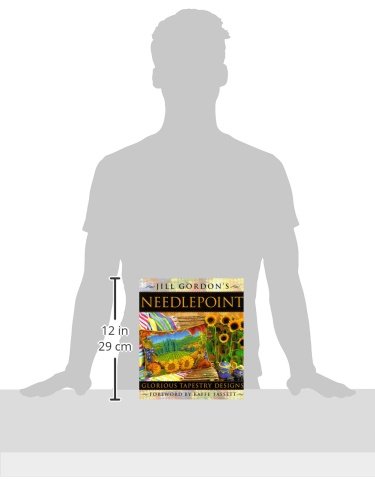
Product Information
Editorial Review
The roots of needlepoint go back thousands of years to the ancient Egyptians, who used small slanted stitches to sew up their canvas tents. Howard Carter, of Tutankhamen fame, found some needlepoint in the cave of a Pharaoh who had lived around 1500 BCE. Modern needlepoint descends from the canvas work in Tent Stitch, done on an evenly woven open ground fabric, that was a popular domestic craft in the 16th century. The development of needlepoint was influenced in the 17th century by Bargello, and by shaded Berlin wool work in brightly colored wool yarn in the 19th century. Upholstered furniture became fashionable in the 17th century, and this prompted the development of a more durable material to serve as a foundation for the embroidered works of art. from Wikipedia
More a wellspring of delicious inspiration than a true how-to book, Jill Gordon's Needlepoint is filled with exquisite ideas and loads of colorful photos of her luscious designs. In their subtle shadings and even their subject matter, they resemble paintings more than traditional needlework--not surprising, since the author confesses a lifelong love of painting and uses watercolor sketches as templates for her tapestries. Some are wonderfully clever (a formal garden depicted as seen through a window, with a brightly cushioned windowseat as the scene's foreground), some are almost abstract in their eloquent repetitions (six flamingos clustered together become a series of salmony-orange nuances); all are highly poetic interpretations of the lush beauty of the natural world: flowers, landscapes, fruits and vegetables, fish, lizards, birds. Gordon explains the origin of each of the 20 designs and lists the canvas and yarns used; she also provides full (and necessarily complex) charts and stitching instructions for 13 of them. These projects are definitely not for the less-experienced needleworker (even intermediate-level stitchers may experience some frustration), but the designs are so lovely and the colors so vibrant that crafters of any skill level will enjoy them, and may even want this volume as a design sourcebook for adaptation to other crafts. --Amy Handy
Specification
Author : Jill Gordon
Binding : Hardcover
Brand : Brand: Friedman/Fairfax Pub
EAN : 9781567992151
Edition : 0
Label : Friedman/Fairfax Pub
Manufacturer : Friedman/Fairfax Pub
NumberOfPages : 160
PackageDimensions_Weight : 2.65 pounds
PackageDimensions : L:11.40 X W:10.10 X H:0.80
ProductGroup : Book
ProductTypeName : ABIS_BOOK
Publisher : Friedman/Fairfax Pub
Studio : Friedman/Fairfax Pub
Title : Jill Gordon's Needlepoint: Creative Tapestry Designs
The roots of needlepoint go back thousands of years to the ancient Egyptians, who used small slanted stitches to sew up their canvas tents. Howard Carter, of Tutankhamen fame, found some needlepoint in the cave of a Pharaoh who had lived around 1500 BCE. Modern needlepoint descends from the canvas work in Tent Stitch, done on an evenly woven open ground fabric, that was a popular domestic craft in the 16th century. The development of needlepoint was influenced in the 17th century by Bargello, and by shaded Berlin wool work in brightly colored wool yarn in the 19th century. Upholstered furniture became fashionable in the 17th century, and this prompted the development of a more durable material to serve as a foundation for the embroidered works of art. from Wikipedia
More a wellspring of delicious inspiration than a true how-to book, Jill Gordon's Needlepoint is filled with exquisite ideas and loads of colorful photos of her luscious designs. In their subtle shadings and even their subject matter, they resemble paintings more than traditional needlework--not surprising, since the author confesses a lifelong love of painting and uses watercolor sketches as templates for her tapestries. Some are wonderfully clever (a formal garden depicted as seen through a window, with a brightly cushioned windowseat as the scene's foreground), some are almost abstract in their eloquent repetitions (six flamingos clustered together become a series of salmony-orange nuances); all are highly poetic interpretations of the lush beauty of the natural world: flowers, landscapes, fruits and vegetables, fish, lizards, birds. Gordon explains the origin of each of the 20 designs and lists the canvas and yarns used; she also provides full (and necessarily complex) charts and stitching instructions for 13 of them. These projects are definitely not for the less-experienced needleworker (even intermediate-level stitchers may experience some frustration), but the designs are so lovely and the colors so vibrant that crafters of any skill level will enjoy them, and may even want this volume as a design sourcebook for adaptation to other crafts. --Amy Handy
Specification
Author : Jill Gordon
Binding : Hardcover
Brand : Brand: Friedman/Fairfax Pub
EAN : 9781567992151
Edition : 0
Label : Friedman/Fairfax Pub
Manufacturer : Friedman/Fairfax Pub
NumberOfPages : 160
PackageDimensions_Weight : 2.65 pounds
PackageDimensions : L:11.40 X W:10.10 X H:0.80
ProductGroup : Book
ProductTypeName : ABIS_BOOK
Publisher : Friedman/Fairfax Pub
Studio : Friedman/Fairfax Pub
Title : Jill Gordon's Needlepoint: Creative Tapestry Designs


